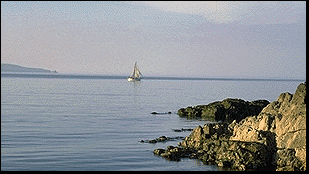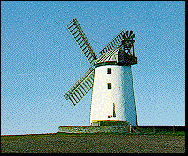 The Ards
Peninsula
The Ards
Peninsula
Original Official Site of the Northern Ireland Tourist Board
 Grey Point, on the county Down coast
Grey Point, on the county Down coast
To burst upon the rollers of the open sea, take the little road from Grey Abbey where terns swoop over Strangford's quiet waters, and drive due east. In a few minutes it's barely three miles to Ballywalter beach - you have crossed to another world.
The two roads that run the length of the Ards on its opposite shores could hardly be more different. The sheltered road is the loughside one.
The breezy coast road from the resort town of Bangor runs south via Donaghadee, passing close to the windmill at Ballycopeland, on to Portavogie harbour where seals bob against the prawn boats as the catch is landed. On it goes, past pretty Kearney village right to the end of the peninsula where the ancient Irish marked their graves with a ring of standing stones and built a fort into the wind on the hill at Tara.
 Ballycopeland windmill
Ballycopeland windmill
The reefs off this coast have claimed many ships in the past. Only Donaghadee offered a safe refuge. In 1818 John Keats took the short crossing from Portpatrick in Scotland, landing at Donaghadee, and walked to Belfast and back. The Lakeland poet Wordsworth, and Franz Liszt (with a piano in his baggage) ended their grand Irish tours here. At low tide the dulse gatherers go down by the lighthouse to collect the edible seaweed growing on the rocks.
The small rounded hills called 'drumlins' that cover north Down extend into Strangford Lough. Dozens of drowned drumlins pop up here and there, mostly near the shore. These islands give the lough the appearance of a freshwater lake, at least at the sheltered northern end, about 18 miles from the narrow entrance at Portaferry. Four hundred million tons of water rush through the gap twice a day, and the Vikings named it 'violent fjord' (Strangford) after the fierce currents in these tidal narrows.
The lough is a great bird sanctuary and wildlife reserve. Thousands of Brent geese spend the winter here and greylag and whitefronted geese visit from the Downpatrick marshes. Oyster catchers, curlews and other wading birds love the mudflats. A hundred different species of fish live in the lough, and sea hares, sun stars and curled octopus sometimes appear on the shore. With so much food readily available, it's not surprising that buzzards, sparrowhawks and short-eared owls make occasional visits. The lough's rich marine life is on display at the Portaferry aquarium.
Round the shores are many interesting and historic places. Take the car ferry from Portaferry across to Castle Ward, built by the first Lord Bangor in 1765. He favoured the classical style but Lady Bangor preferred Strawberry Hill Gothic. As you will see, they both got their way. Another great loughside demesne open to the public is Mount Stewart, the childhood home of Lord Castlereagh, foreign secretary of England during the Napoleonic wars. The estate has delightful gardens, and dodos and dinosaurs on the terraces.
Strangford was a desirable address many centuries before the Anglo-Irish built their great houses. Of the four Cistercian monasteries in medieval county Down, three were built round the lough - Inch Abbey, Grey Abbey and Comber. The fourth was at Newry, the town that guarded the strategically important Gap of the North.
Only Inch Abbey and Grey Abbey have substantial remains. Founded in 1193 by Affreca, wife of John de Courcy, Grey Abbey had a big stone fishery and the monks built fish traps out of wattles.
County
Down Overview | Exploring
County Down | Ards Peninsula | Mourne
Mountains |
St. Patrick's Country |
Northern Ireland Homepage | Travel Tips | Golf | Industrial Heritage | Walking, Hiking & Horseback | Activities | Calendar of Events | Transportation | Cuisine and Restaurants | Birdwatching | Fishing | Ancestral Heritage | County Antrim | County Armagh | City of Belfast | County Down | County Fermanagh | County Londonderry | County Tyrone | Tour Operators | InterKnowledge Home Page
Copyright (c) 1995-1997 interKnowledge Corp. All rights reserved.
